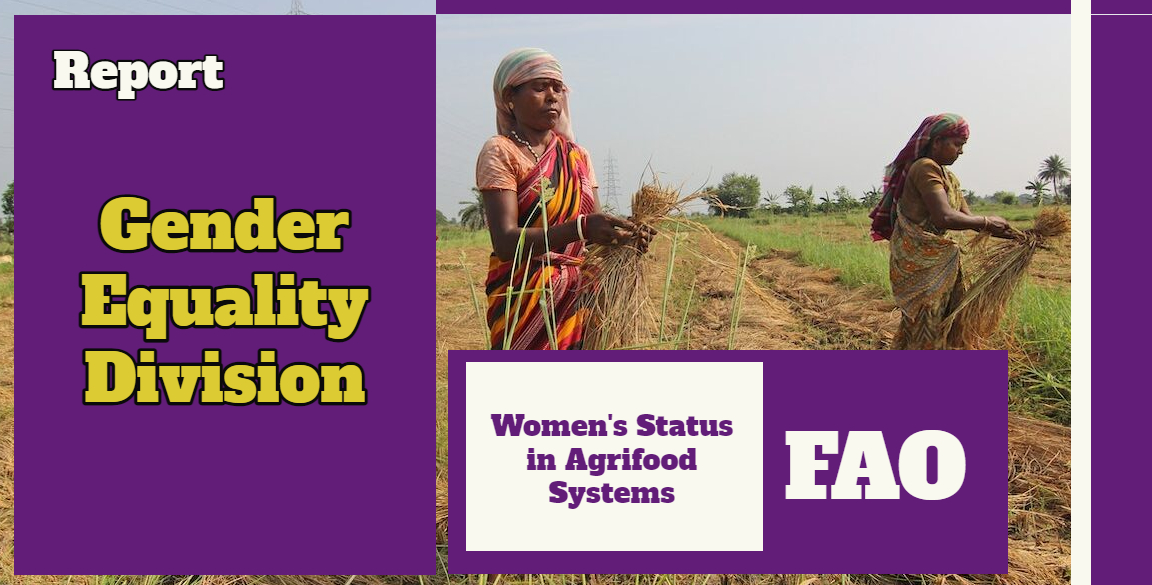News
the FAO On Women’s Status in Agrifood Systems.
Published
1 year agoon

Women’s Status in Agrifood Systems: The Inclusive Rural Transformation and Gender Equality Division (ESP) of FAO produced this FAO Report.
FAO Report on The Status of Women in Agrifood Systems
This report is the first of its kind since the State of Food and Agriculture (SOFA) 2010–11 report on women in agriculture, which was produced by the FAO’s Inclusive Rural Transformation and Gender Equality Division (ESP). Beyond the confines of agriculture alone, it provides a thorough overview of the situation of women working in agri-food systems, covering all aspects from production to distribution and consumption.
Read Also:- On April 20, PM Modi will speak at the World Buddhist Summit.
Key Findings of the FAO Report on The Status of Women in Agrifood Systems
With 36% of working women and 38% of working men employed in this industry, agricultural and food systems offer significant employment opportunities for both sexes globally.
However, since 2005, there has been a 10% decline in employment in primary agricultural production, which has impacted people of both sexes.
In this industry, women are more likely to work part-time or in risky positions. There is also a 24% difference in the productivity of land between farms run by men and women of comparable size.
Women make up 21% of the workforce in the fisheries and aquaculture primary sector, and they make up nearly 50% of the workforce throughout the entire aquatic value chain (including pre- and post-harvest).
In many nations, women depend more on agrifood systems than men do for their livelihoods, with 71% of women’s jobs in southern Asia and 66% of women’s jobs in sub-Saharan Africa respectively.
Women in wage employment in agriculture make 82 cents for every dollar earned by men, reflecting the pervasive gender wage gap.
In most nations reporting on Sustainable Development Goal Indicator 5.a.1, women have less ownership and secure tenure rights over agricultural land than men do.
Women’s Status in Agrifood Systems: FAO Report Availability of Gender Equality
In recent years, gender equality has made some progress, with the gender gap in access to mobile internet and bank accounts in low- and middle-income countries narrowing. However, the disparity in food insecurity between men and women has grown as 22% of women and only 2% of men lost their jobs in the off-farm sector of the agrifood systems during the COVID-19 pandemic.
A 1% increase in global GDP (or almost $1 trillion USD) and a 2% decrease in global food insecurity, benefiting 45 million people, would result from closing the gender wage and productivity gaps in agriculture and the agrifood sector, respectively.
Millions of people’s incomes and resilience could be greatly improved by empowering women in small-scale production. A review of 13 agricultural development projects revealed conflicting results regarding the empowerment of women. Through interventions in crops, livestock, and nutrition, these projects sought to improve income and nutritional outcomes.
You may like
-


North Korea asserts that the test of a multiple-warhead missile was successful
-


The Student Wing of Congress storms the Exam Body NTA office and locks it from within
-


“During President Murmu’s address to Parliament, PM Modi was shown 73 times, and LoP Rahul Gandhi was shown six times”: Congress
-


NASA contracts Elon Musk’s SpaceX to deorbit the International Space Station in 2023.
-


A Caution For The CBI In The Delhi Court’s Arvind Kejriwal Custody Order
-


Bar Council of India requests that bar associations abstain from demonstrating in opposition to new criminal laws
